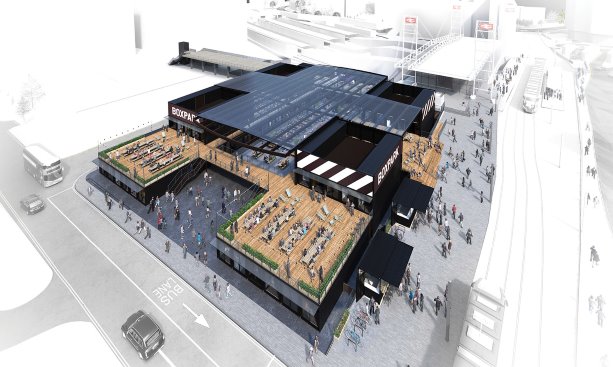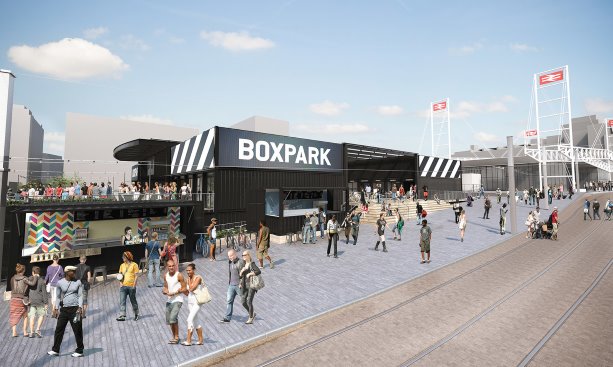A second London shopping mall built with steel shipping containers is set to open as the trend of using these boxes as modern day Lego blocks for structures further takes root.
Boxpark Croydon is on schedule to open this summer, said Matthew McMillan, development director of Boxpark, which opened its first shipping container strip mall in Shoreditch in East London in 2011, pioneering the concept. It will use up to 100 steel containers in a glass atrium covered mall which will house independent food and beverage services for hungry commuters, local residents and office workers.
Steel shipping containers have long been used for almost everything in addition to actually shipping goods: as storage containers, building blocks for cottages and homes and as standalone stores. However, the idea of grouping together 100 or more containers in a single location with a single landlord is novel.
In 2008, for example, architects LOT-EK envisioned Puma City, 24 shipping containers locked together as an 11,000 square-foot pop-up retail store, three storeys high with a double-height ceiling and bar area in Boston. In New Zealand, the Re:START container mall was the rapid response to the earthquake which devastated Christchurch in 2011. Instead of waiting for permits to be processed the local planning authority opted for a fast track option using steel containers.
At the outset Re:START comprised of 27 businesses and since has grown to be a standalone tourist attraction with 50 enterprises. A new bricks and mortar retail mall and offices will be built at the northern end with some containers being relocated to another part of the site.
There’s also a similar mall in Buenos Aires, Argentina and even Toronto has its own mini-mall version called Market 707 at Scadding Court, near Dundas Street West and Bathurst Street, where the sidewalk has been transformed into a marketplace with several containers serving as restaurants, a bicycle repair shop and a grocery store. The units are standalone and not connected.
In London, Boxpark is a reaction to the high cost of land in that city and the perilous state of retail, said McMillan. Areas like Shoreditch and Croydon have been late to the regeneration party which has swept almost all of London. Building with shipping containers also sped up the construction schedule so they could open in just 12 months after getting the greenlight.
It’s far from an experimental novelty. The location is prime, adjacent to East Croydon railway station which offers dozens of trains direct to Central London for some 27 million passengers passing through every year. There’s also a new connecting LRT line which has had a dynamic impact on the area.
The regeneration is also being spurred by the $3 billion redevelopment of a nearby shopping mall in a pedestrian zone which will be razed and rebuilt. There is also about $4 billion in new development in the area which in turn is attracting new tech startups, investors and the inevitable hipsters who are going to be hungry, McMillan said.
"There’s really nowhere for the 25,000 people who will be there to go out for something to eat," said McMillan, noting 72 of the 97 units will be leased as food and beverage units, with the others being used for storage and administration. Boxpark sites don’t require intensive development, McMillan said, just a concrete pad with utility access.
The land is leased so the owner can realize some income and create buzz before they’re ready to develop. The containers are bought new and then refitted to Boxpark specifications with holes cut for windows, doors and interconnections. Reinforcement is added to compensate for those cuts. The container is fitted with insulation where required, wiring and plumbing connections.
The average unit consists of four to five containers linked together. Units used for food and beverage services are fitted with modular kitchen equipment. The base units are set on "sleepers" and then the other units attached with the option for two or three storeys. The other benefit, of course, is that start-up costs are relatively low since the land is leased. Once the lease terminates the containers can be dismantled and moved either for salvage or redeployment.
Though the novelty of a mall built with steel shipping containers brings ease of construction and drives interest, there has to be more there to sustain traffic, said McMillan.
As such, tenants, especially those selling clothing or other goods, also get the back office support offered by Boxpark which integrates marketing options such as advertising, online retailing through eBay and other services.
"We don’t work with big global brands, though at Shoreditch we did work with the Gap with their GapFit line, which they were experimenting with."
"It really is plug and play," he said. "They can open up at Boxpark and within an hour be online."
Retail brands are struggling around the world, he said, and it’s not enough just to design a mall with two major anchor tenants to draw traffic for the other stores between them. At the same time, young brands find it hard to get a foothold as more and more main street shopping districts become homogenized and overrun with the same national brands.
"We work more on a gut feel," he said. "If we like you we want to work with you."












Recent Comments
comments for this post are closed